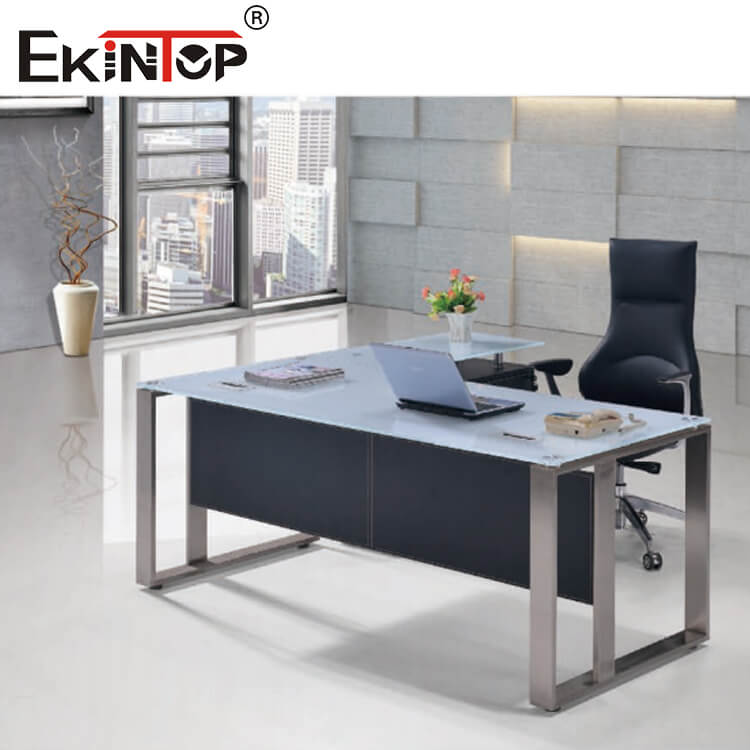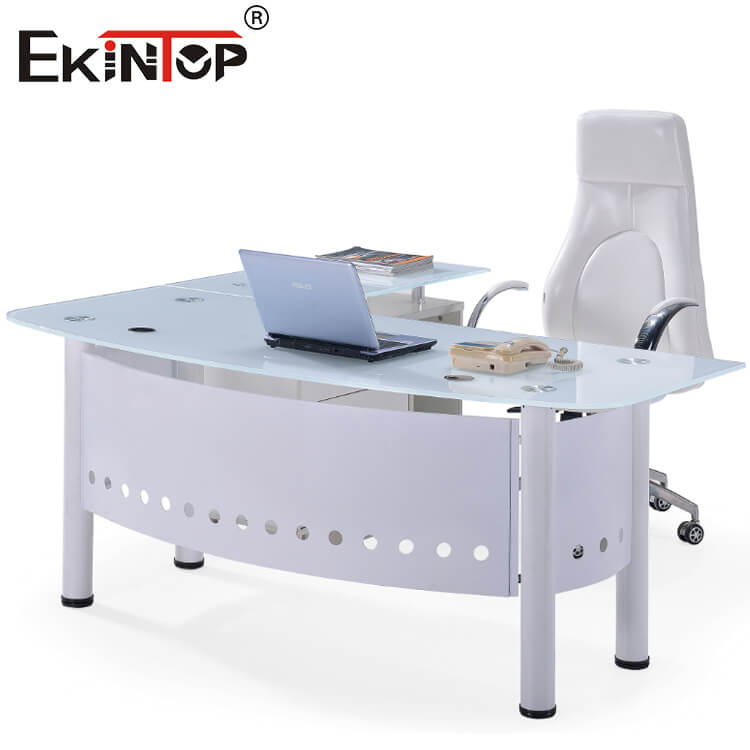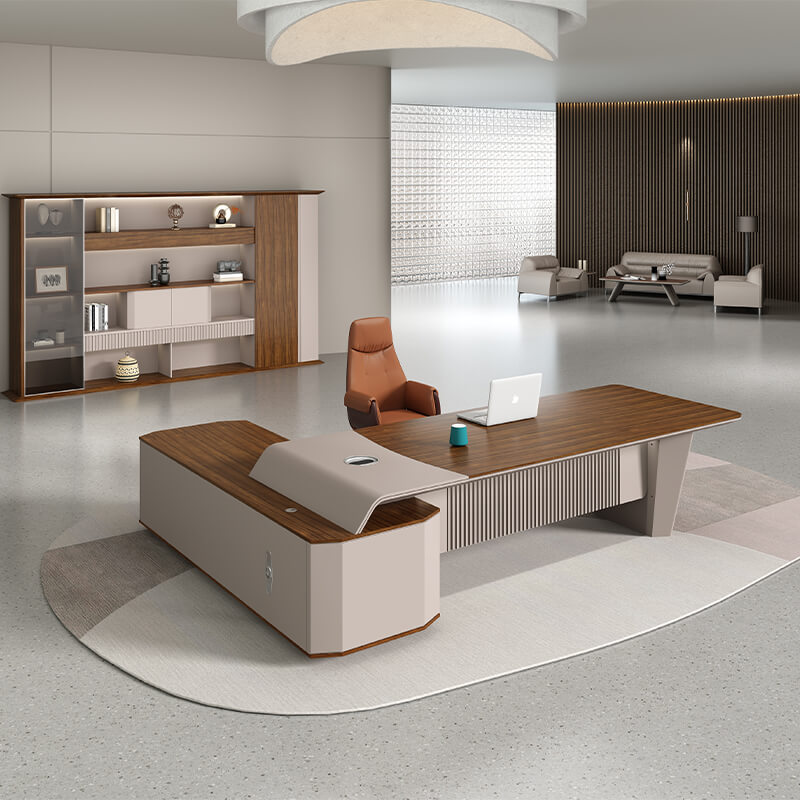
October 15,2025
admin
At Tesla’s Berlin Gigafactory R&D center, an office desk made of graphene composite material maintains the surface temperature with a precision of 0.03°C. The area where engineers rest their elbows automatically softens, forming an ergonomic dip. This illustrates how office desk materials have gone beyond traditional understanding, becoming a composite carrier that integrates material science, bioengineering, and information technology.
1. The Technological Rebirth of Traditional Materials
2. Disruptive Applications of New Materials
3. Black Tech in Surface Treatments
4. Dual Breakthroughs in Environmental Tech
The Molecular Revolution of Engineered Wood
High-Density Fiberboard (HDF) has been enhanced using nanocellulose technology, increasing its bending strength to over 50 MPa—three times greater than traditional solid wood desk. Columbia Forest Products in the U.S. has introduced PureBond technology, which replaces urea-formaldehyde resin with soy protein adhesive, reducing formaldehyde emissions to 0.003 ppm, meeting Japan’s F4 Star standard. The surface treatment uses synchrotron radiation curing coatings, with a wear resistance of up to 200,000 cycles.
The Lightweight Breakthrough of Metal Substrates
Aerospace-grade magnesium-aluminum alloy, processed by Equal Channel Angular Pressing (ECAP), increases yield strength to 380 MPa, while being 57% lighter than steel. Germany’s Interstuhl has developed micro-arc oxidation technology that generates a 20μm ceramic layer on aluminum, achieving a hardness of HV1500, with scratch resistance surpassing that of stainless steel.
The Performance Iteration of Glass Materials
Corning’s 6th generation Gorilla Glass undergoes chemical tempering, achieving surface compressive stress of up to 1000 MPa and a drop resistance exceeding 2 meters. Germany's Schott developed AntiReflect glass, which uses a nanoporous coating to increase light transmittance to 99.6%, while reducing reflectance to 0.2%, completely eliminating screen ghosting.

The Office Revolution with Carbon Fiber Composites
Toray's T1100-grade carbon fiber combined with an epoxy resin matrix reduces the desk panel thickness to 5mm, while maintaining a load capacity of 300 kg/m². The BMW i-series production line technology has been scaled down, enabling a 1.5-minute hot-press molding cycle, reducing energy consumption by 83% compared to traditional wooden desks.
Ecological Evolution with Bio-based Materials
Dutch company DESSO has developed mycelium-based substrates that solidify 15 kg of CO₂ per square meter in just 28 days of growth. After being coated with chitosan, the material achieves an antibacterial rate of 99.7% and a bending strength of 32 MPa. After disposal, it is fully biodegradable, with a carbon footprint just 1/9 that of traditional materials.
The Application of Smart Responsive Materials
MIT has developed mechanical metamaterials that dynamically adjust desk surface stiffness through microstructural deformation: local hardening to Shore D80 when writing, and softening to Shore A30 in the elbow support area. Pressure sensors achieve a precision of 0.1N and can store 20 common posture parameters.

Quantum Coatings for Optical Control
Switzerland’s INSOLIGHT uses Atomic Layer Deposition (ALD) technology to construct 125 layers of nanofilms on glass surfaces. By adjusting electron cloud density, the transparency can be tuned between 5% and 95%, with a response time of 0.2 seconds and energy consumption only 1/20th that of electrochromic technologies.
Self-Healing Coatings in Commercial Applications
BASF has developed a biomimetic polymer coating containing 5 million micro-capsules per cm². When scratches over 5μm are detected, the repair agent is released, completing molecular-level repair in 40 seconds, reducing maintenance costs by 79%. UL laboratory tests show that the repair cycle can reach up to 2,000 times.
Bionic Texture for Tactile Revolution
3M’s micro-replication technology replicates the surface structure of shark skin with an accuracy of 0.05mm, controlling the friction coefficient between 0.35 and 0.55. Tactile feedback tests show that this design improves writing smoothness by 33% and reduces wrist fatigue by 61%.

Performance Beyond Recycled Materials
Interface’s Net Effect series converts recycled fishing nets into nylon-6 fibers. After solid-state polymerization, the wear resistance reaches 150,000 cycles, and impact strength is 40% higher than that of virgin plastic. Each square meter of desk surface contains 3.2 kilograms of ocean plastic waste.
Invisible Integration of Photovoltaic Materials
Switzerland’s CSEM has developed transparent photovoltaic films that maintain 85% visible light transmittance while achieving a conversion efficiency of 12.3%. A 1.5㎡ desk can generate 180 kWh of electricity per year, fully powering the LED lighting system.
Real-World Applications of Carbon Capture Materials
UK-based CarbonCure technology injects CO₂ into concrete bases, mineralizing 25 kg of CO₂ per cubic meter of material. Combined with geopolymers, the compressive strength reaches 80 MPa, turning the desk's carbon footprint negative.
At Microsoft’s Future Office Lab, a smart desktop with quantum sensors is optimizing material performance in real time: adjusting local elasticity modules based on contact pressure and fine-tuning the surface friction coefficient according to environmental humidity. This marks the evolution of office desk materials from static substances into intelligent media with environmental awareness. When material science breaks through molecular control limits and sustainable development concepts penetrate to the atomic level, the ultimate form of the office desk will be a technological symbiosis between humanity and nature.
By choosing Ekintop's material solutions, you gain not only office furniture but also a technological carrier for the zero-carbon future.

